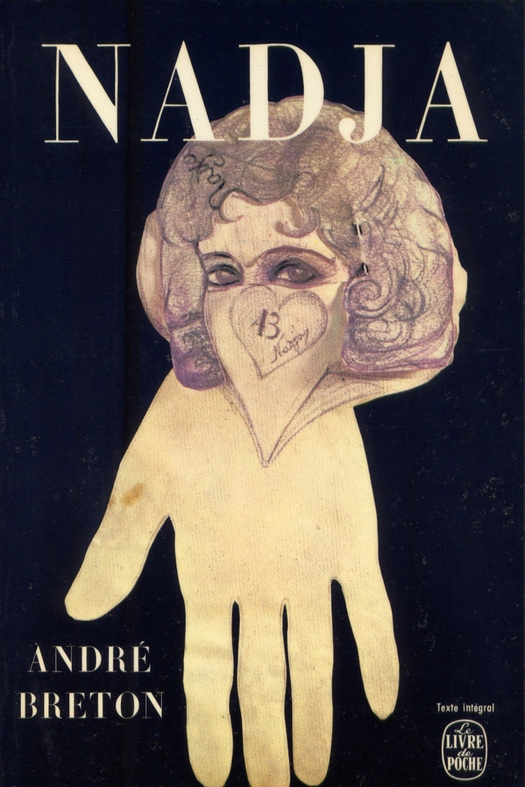
Published by Gallimard in Le Livre de poche, 1964. Design: Pierre Faucheux. Art: Nadja
Soon after he started designing book covers for Le Livre de poche — see my earlier post — Pierre Faucheux learned that the imprint planned to issue a pocket edition of Nadja by André Breton. The memoir, case study or romance, first published in Paris in 1928, is a classic of Surrealist literature often thought to be the text that best expresses the Surrealist mentality and attitude.
In October 1926, Breton (1896-1966) noticed a young, poorly dressed, delicate looking woman walking towards him in the street. “I had never seen such eyes,” he writes. “Without a moment’s hesitation, I spoke to this unknown woman.” She told him she called herself Nadja, “because in Russian it’s the beginning of the word hope, and because it’s only the beginning.” For several days, they met repeatedly, encounters often attended by peculiar occurrences and coincidences, until Breton tired of Nadja’s erratic behavior and began to withdraw, despite her entreaties. At the end, he reveals that he had been told a few months ago “Nadja was mad.” After causing a disturbance in the corridors of her hotel, she was taken to an infirmary.
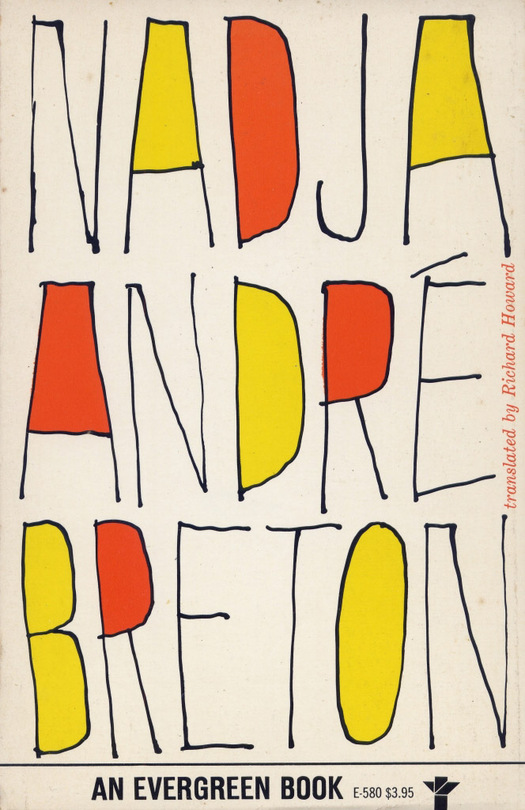
Published by Grove Press, 1960. Design: Roy Kuhlman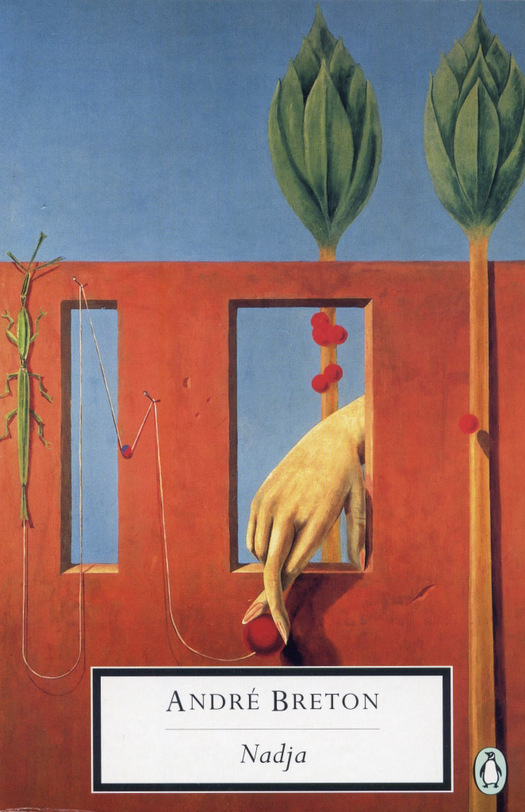
Published by Penguin, 1999. A detail from At the First Clear Word, 1923, by Max Ernst
The first English-language edition of Nadja didn’t appear until 1960 when Richard Howard translated it for Grove Press. By the time I bought a copy in the early 1980s, with the Roy Kuhlman cover it carries to this day, it was in its 11th printing. It still took until 1999 for Penguin to publish Howard’s translation in Britain as a “twentieth-century classic.” I’ll return to those editions in a moment.
Faucheux knew Breton. In 1955, he had designed a clever new edition of Breton’s Surrealist manifestos complete with a magnifying glass hidden inside some cutaway pages — I showed it in “Uncanny: Surrealism and Graphic Design.” In 1959, Faucheux undertook a role described as “chief-operator” by Alyce Mahon in Surrealism and the Politics of Eros, 1938-1968, in the design of “EROS,” an international Surrealist exhibition held in Paris; he recalls in his graphic memoir Écrire l’espace that Breton gave him carte-blanche both there and in a 1965-66 exhibition, “L’Écart absolu” (“Absolute Deviation”). He also acknowledges in the book the influence of the Surrealists on his way of thinking: “The creative activity of the Surrealists, their access to the unconscious, fascinated me and the lessons of their irrationality seemed to me a crucial victory against the pragmatism and materialism of the century. Surrealist poets and creators radically cleansed my mind of the provincial education I had received.”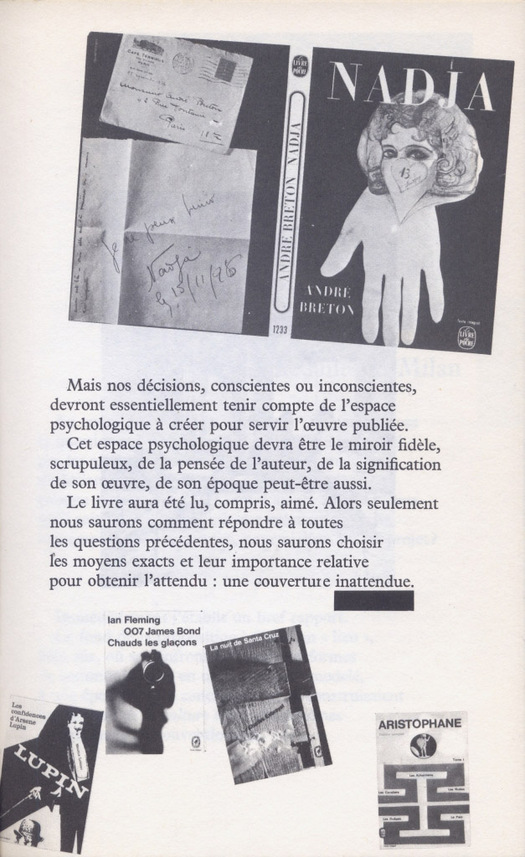
Page from Écrire l’espace by Pierre Faucheux. Published by Robert Laffont, 1978
Faucheux called Breton and asked him whether he still possessed any letters from Nadja. It was an inspired line of inquiry because Breton had kept many of her messages (these can be seen online at Breton’s archive and French Wikipedia has extensive quotations). In his monograph, Faucheux recalls: “He entrusted me with a paper cutting by Nadja, one of her last letters, the one in which she wrote about the Hotel Terminus: ‘I cannot come tonight.’ I photographed these documents to look convincing. Readers could not be insensitive to the authenticity of the document. The signal was there.” On the front cover (top), the designer showed one of Nadja’s hand-drawn paper cuttings described by Breton in the text and shown in the book.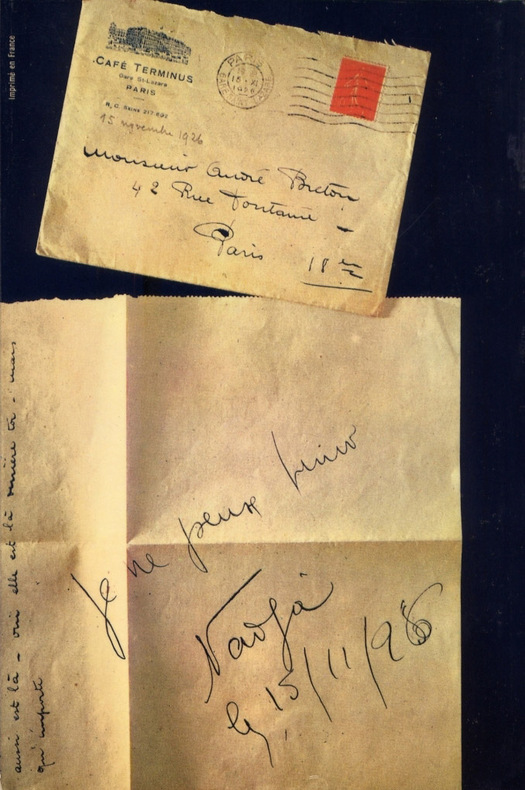
Le Livre de poche, 1964. Letter to Breton from Nadja, 15 November 1926. Design: Pierre Faucheux
The drawing is one of 44 images — photographs, pieces of print, art works, and drawings by Nadja — that punctuate Breton’s fragmentary reflections. The book is sometimes incorrectly described as a novel, though the pictures of streets, squares, hotels and restaurant exteriors are meant to authenticate the locations where these mysterious and, for Breton, marvelous encounters took place. That doesn’t mean his autobiographical account can be regarded as an unvarnished record of events. There are photographs by Man Ray and Henri Manuel of people he mentions, including the Surrealists Paul Éluard, Benjamin Péret and Robert Desnos, the actress Blanche Derval, and Breton himself, but notoriously, there is no photograph of Nadja, who comes to seem more like a phantasm of Breton’s overwrought poetic imagination, a muse, than a living person; at no point do we learn her real name. Breton did add a montage of Nadja’s eyes to the 1964 Livre de poche edition; he also changed another photo, added four more new pictures, and deleted details suggesting that he and Nadja spent a night together in a hotel.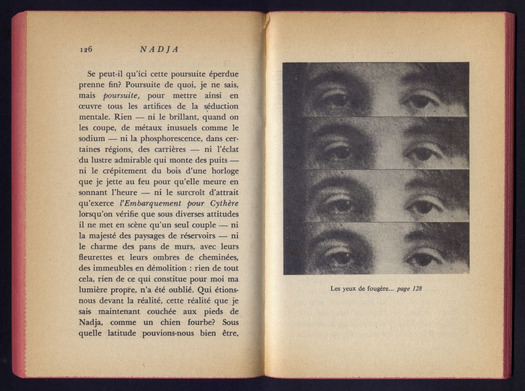
Le Livre de poche, 1964. Picture caption reads: “The eyes of fern . . .”
Despite these superfluous revisions near the end of Breton’s life, the Livre de poche edition remains the best one to see to gain the full impact of the photographs and other images. In the Grove Press edition, the pictures are small relative to the page size, and gray, showing obvious signs of having been reproduced from the pages of Gallimard’s French edition. The effect is even murkier in the Penguin edition, which simply reproduces the Grove Press layouts — a copy of a copy — leading to grating distortions of tone in the pictures. Éluard’s eyes shine out of his darkened face like glowing bulbs, and I don’t mean that as a Surrealist compliment. None of the street photos that Breton asked his Surrealist colleague Jacques-André Boiffard to take for the book have credits in either the Grove or Penguin editions. However, these editions do follow Breton’s original text and retain his first selection of pictures.
The Livre de poche edition has smaller pages, while all of the images are bigger, making for a much more satisfactory balance of picture against text area. The images are also darker, with correctly printed mid tones, and punchier in detail. More complete picture credits, although there are still omissions, enhance the pocket version. Gallimard’s later Folio edition should be avoided, though — the faded images are worse than Penguin’s. This is the kind of visual deterioration that W.G. Sebald used strategically to complicate the reader’s response to the veracity of the images interspersed in his narratives, but Nadja works differently. Boiffard’s famously deadpan, depopulated and far from picturesque pictures of the Saint-Ouen flea market, the Humanité bookstore and the Sphinx Hotel gain in mystery the more solid and definite they become (the Breton archive has proofs of most of the illustrations). Breton wanted a “medical” style of dispassionate observation in the images, as well as the writing, and Boiffard, like Breton, had been a medical student. “Perhaps life needs to be deciphered like a cryptogram,” writes Breton. Still, he appears to have had mixed feelings about the photographs in Nadja, describing the images soon after publication as “dreary and disillusioning,” while nevertheless dedicating a copy to Boiffard with the encomium (perhaps it was faint praise) that his were “the most beautiful photographs in this book.”
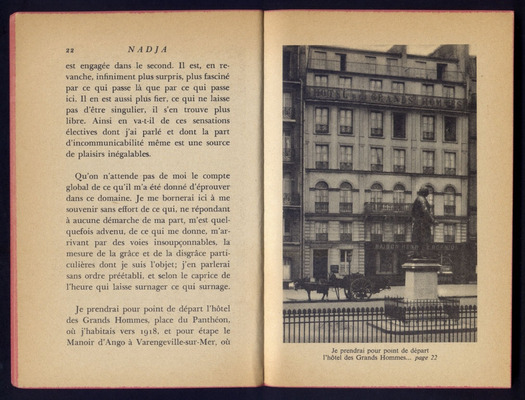
Le Livre de poche, 1964. Photograph: Jacques-André Boiffard
Picture caption reads: “I shall take as my point departure the Hôtel des Grands Hommes . . .”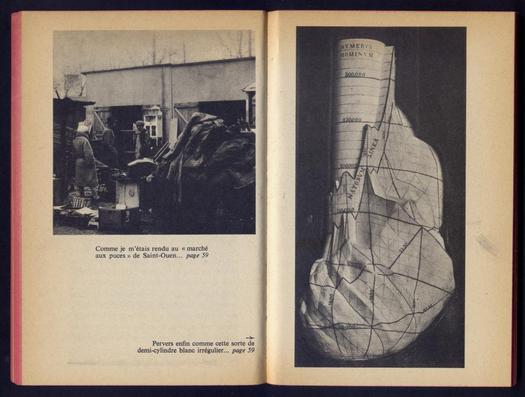
Le Livre de poche, 1964. Photograph, left: Jacques-André Boiffard
Picture caption, left, reads: “As I arrived at the Saint-Ouen flea market . . .”
Picture caption, right, reads: “Even perverse, like that kind of irregular white half-cylinder . . .”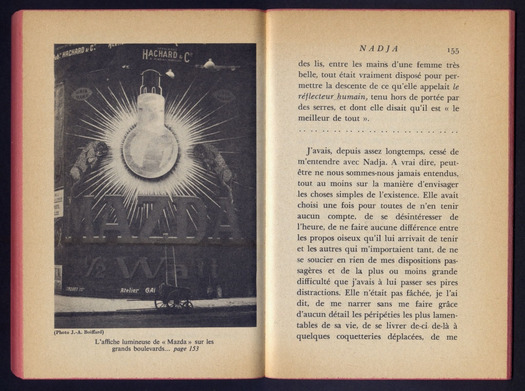
Le Livre de poche, 1964. Photograph: Jacques-André Boiffard
Picture caption reads: “The luminous Mazda sign on the great boulevards . . .”
W.G. Sebald’s books are the most immediate contemporary reference point for Breton’s use of “embedded” imagery in Nadja, which is one of the earliest entries in this genre. Searching for Sebald (2007), an intensive study of Sebald and photography, contains a wonderful essay comparing Nadja and Austerlitz, which starts with the image of the hand seen in Nadja’s paper cutting on the cover, and with a photo in the book of a bronze glove left by a woman visitor to the Surrealists’ office.
Patti Smith quoted Nadja’s resounding final line — “Beauty will be CONVULSIVE or will not be at all” — on the back of her 1976 album Radio Ethiopia, and in a book list for the Melbourne Festival in 2008 the poet and singer cited Nadja as one of her favorite volumes. Breton’s classic was in Smith’s mind when it came to the writing and construction of Just Kids, her recent memoir about her relationship with the photographer Robert Mapplethorpe. “I studied how books are designed, from paper to font,” she said in an interview. “In working with the book designer I chose to integrate the visual material within the text as in Nadja by André Breton or Austerlitz by W.G. Sebald.” Smith also used the Breton-Sebald method of text interruption, working with many of her own photos, in an expanded edition of her earlier memoir Woolgathering, published in 2011. It’s worth mentioning that two later works by Breton also feature embedded imagery: Les Vases communicants (1932, Communicating Vessels) and L’Amour fou (1937, Mad Love).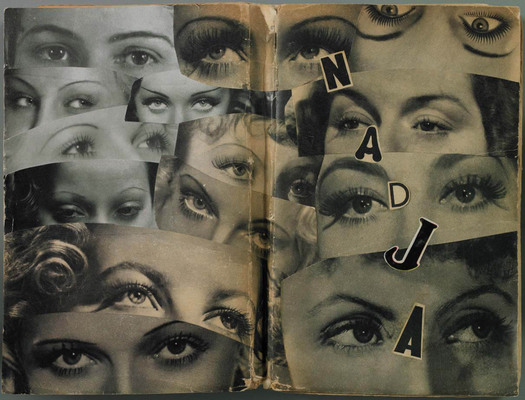
Cover of the 1928 Gallimard edition of Nadja, collaged over by Marcel Mariën, 1938. Source: Ronny van de Velde
A final word on Nadja herself. Who was the troubled and ultimately tragic woman who became the subject of one of Surrealism’s most enduring books? In Mark Polizzotti’s Revolution of the Mind: The Life of André Breton (1995), Nadja was revealed to English-speaking readers as Léona Camile Ghislaine D. — despite his exhaustive efforts (it’s a huge book) he had found it impossible to discover her last name. She was born near Lille in 1902. She’d had a baby as a teenager and left her daughter with her parents to go to Paris, where she lived a precarious existence.
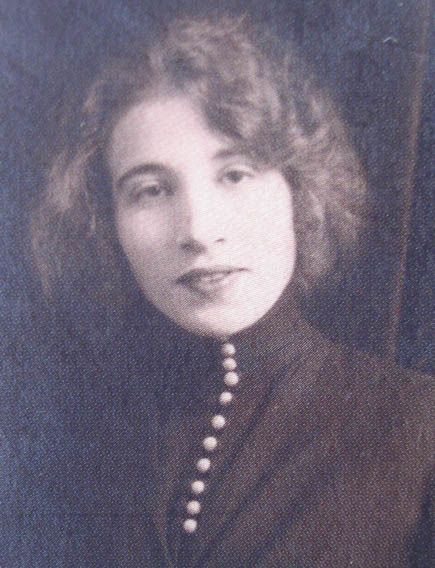
Léona Delcourt (Nadja), 1920s. Source: Jacques Rigaut
With thanks to Catherine Guiral.
See also:
Pierre Faucheux and Le Livre de Poche
W.G. Sebald: Writing with Pictures
On the Threshold of Sebald’s Room
On My Shelf: A Classic by Berger and Mohr


Comments [4]
this text and images are full of interest and originality. It reminds me your text from the exhibition about Surrealism and Graphic Design published in étapes 13 (Spain). Great post.
Lucas
08.21.12
09:57
Great post. Very cool.
Also check out kcrw Bookworm
with host Michael Silverblatt & W.G. Sebald.
http://www.kcrw.com/etc/programs/bw/bw011206w_g_sebald
08.21.12
09:08
And I just noticed that an article I did for Creative Review about Surrealism and photography titled "Surrealism: The Enduring Appeal of Convulsive Beauty" is also available online.
08.23.12
01:34
Thank you for the great article! I am curious if you have any more information as to why Breton included more photographs/changed angles/edited the text or is there a good source for the publication history of Nadja?
Best,
Meredith
11.24.12
05:45